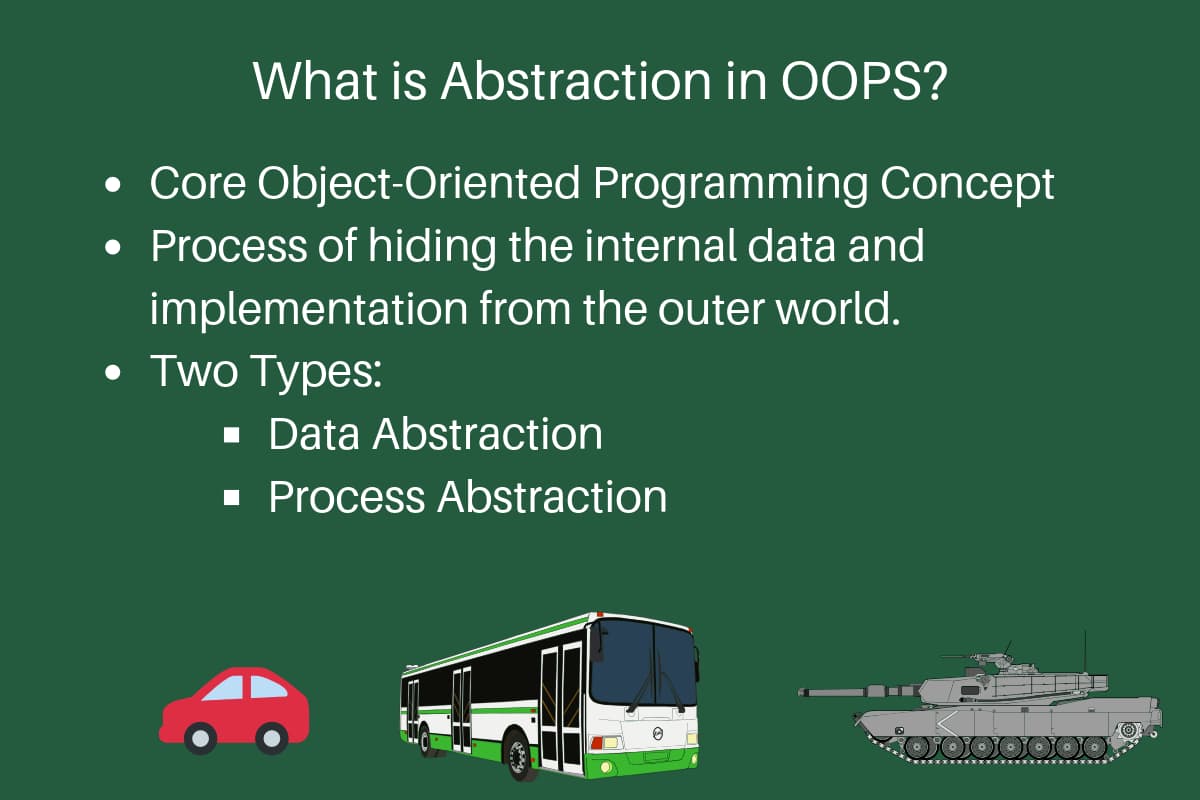Abstraction is one of the core concepts of Object-Oriented Programming. Abstraction defines a model to create an application component. The implementation of abstraction depends on the language-specific features and processes.
1. What is Abstraction?
Abstraction is the process of hiding the internal details of an application from the outer world. Abstraction is used to describe things in simple terms. It’s used to create a boundary between the application and the client programs.
2. Abstraction in Real Life
Abstraction is present in almost all the real life machines.
- Your car is a great example of abstraction. You can start a car by turning the key or pressing the start button. You don’t need to know how the engine is getting started, what all components your car has. The car internal implementation and complex logic is completely hidden from the user.
- We can heat our food in Microwave. We press some buttons to set the timer and type of food. Finally, we get a hot and delicious meal. The microwave internal details are hidden from us. We have been given access to the functionality in a very simple manner.
3. Abstraction in OOPS
Objects are the building blocks of Object-Oriented Programming. An object contains some properties and methods. We can hide them from the outer world through access modifiers. We can provide access only for required functions and properties to the other programs. This is the general procedure to implement abstraction in OOPS.
4. What are the different types of abstraction?
There are two types of abstraction.
- Data Abstraction
- Process Abstraction
4.1) Data Abstraction
When the object data is not visible to the outer world, it creates data abstraction. If needed, access to the Objects’ data is provided through some methods.

4.2) Process Abstraction
We don’t need to provide details about all the functions of an object. When we hide the internal implementation of the different functions involved in a user operation, it creates process abstraction.

5. Abstraction in Java
Abstraction in Java is implemented through interfaces and abstract classes. They are used to create a base implementation or contract for the actual implementation classes. Car.java: Base interface or abstract class
package com.journaldev.oops.abstraction;
public interface Car {
void turnOnCar();
void turnOffCar();
String getCarType();
}
ManualCar.java, AutomaticCar.java: implementation classes of Car.
package com.journaldev.oops.abstraction;
public class ManualCar implements Car {
private String carType = "Manual";
@Override
public void turnOnCar() {
System.out.println("turn on the manual car");
}
@Override
public void turnOffCar() {
System.out.println("turn off the manual car");
}
@Override
public String getCarType() {
return this.carType;
}
}
package com.journaldev.oops.abstraction;
public class AutomaticCar implements Car {
private String carType = "Automatic";
@Override
public void turnOnCar() {
System.out.println("turn on the automatic car");
}
@Override
public void turnOffCar() {
System.out.println("turn off the automatic car");
}
@Override
public String getCarType() {
return this.carType;
}
}
User Program: Let’s look at a test program where the Car functions will be used.
package com.journaldev.oops.abstraction;
public class CarTest {
public static void main(String[] args) {
Car car1 = new ManualCar();
Car car2 = new AutomaticCar();
car1.turnOnCar();
car1.turnOffCar();
System.out.println(car1.getCarType());
car2.turnOnCar();
car2.turnOffCar();
System.out.println(car2.getCarType());
}
}
The client program only knows about the Car and the functions that the Car provides. The internal implementation details are hidden from the client program. References: Wikipedia, Oracle Docs
Thanks for learning with the DigitalOcean Community. Check out our offerings for compute, storage, networking, and managed databases.
While we believe that this content benefits our community, we have not yet thoroughly reviewed it. If you have any suggestions for improvements, please let us know by clicking the “report an issue“ button at the bottom of the tutorial.

Nice theme and logo sir, Now it’s much better to study any topic
- Micky
Wow. Just change relapse ‘Abstraction’ with ‘Encapsulation’ and it will be a nice article.
- John
I am new in programming, especially OOP. Your article is good. Hope I will be able to master it. Thanks and best wishes.
- Ayorinde
Your definition of abstraction is definitely that of encapsulation and not of abstraction. Abstraction is a model of real-world objects limited to a specific context where we represent details related to that context with high accuracy and omit the rest! Encapsulation is what you defined abstraction. Thanks for the effort!
- A. Rouabah
Yes concept for abstraction is like showing essential things and hiding non essential things and this can be achieved through the Java abstract or interfaces creations.
- Mukthiyar
Awesome Really I understand
- Kishan Patel
Difference between Abstract Class and Interface An abstract class can have both abstract and non-abstract methods. The interface can have only abstract methods. An abstract class does not support multiple inheritances. An interface supports multiple inheritances. An abstract class can provide the implementation of the interface. An interface can not provide the implementation of the abstract class. An abstract class can have protected and abstract public methods. An interface can have only have public abstract methods. An abstract class can have final, static, or static final variable with any access specifier. The interface can only have a public static final variable.
- Mukthiyar
Difference between Abstraction and Encapsulation Abstraction solves the issues at the design level. Encapsulation solves it implementation level. Abstraction is about hiding unwanted details while showing most essential information. Encapsulation means binding the code and data into a single unit. Abstraction allows focussing on what the information object must contain Encapsulation means hiding the internal details or mechanics of how an object does something for security reasons.
- Mukthiyar
Nice Explanation ,but need more details
- S Sarath